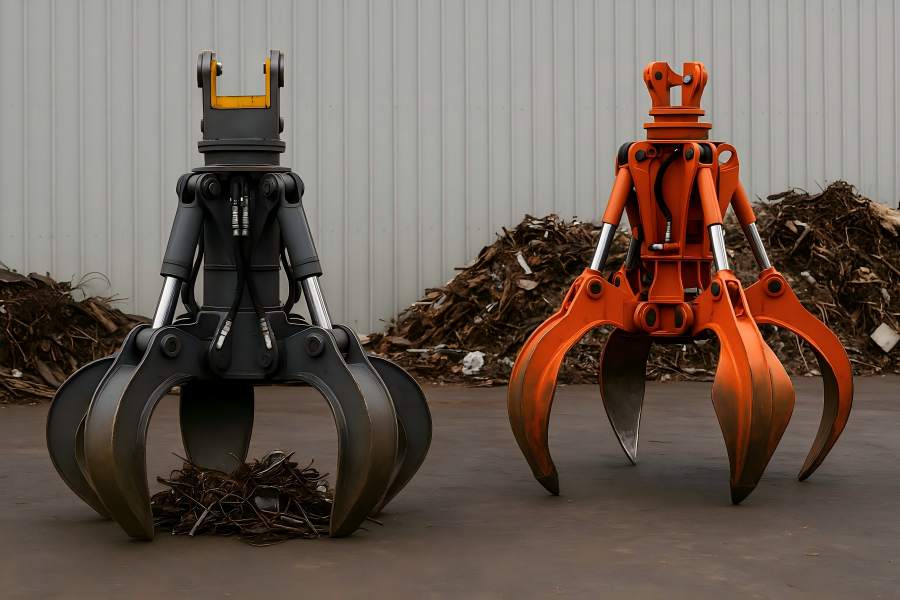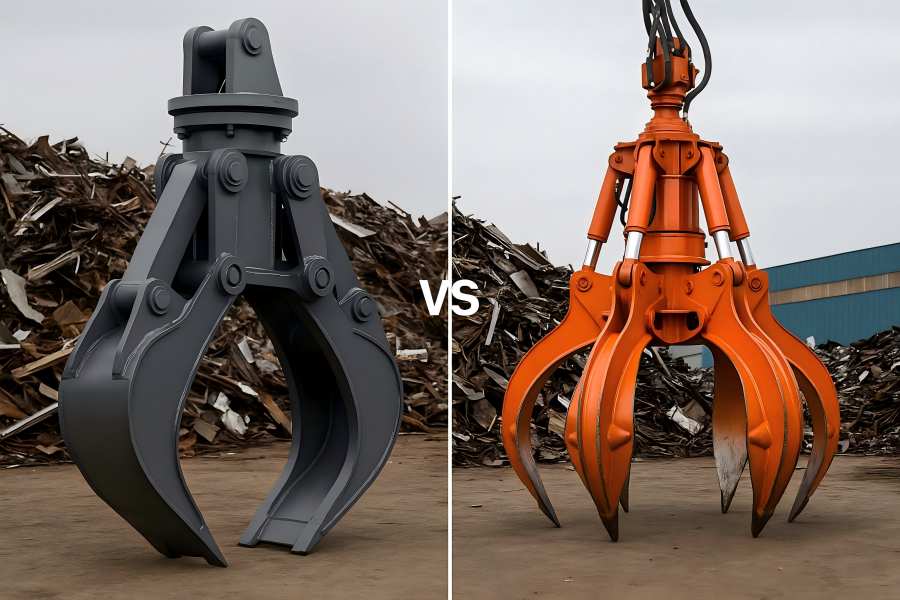In the world of recycling and bulk material handling, efficiency and durability are the cornerstones of productivity. Choosing the right grab attachment can determine whether your operation runs smoothly or suffers from frequent downtime and material loss.
Two of the most popular options for scrap handling are the hydraulic scrap grab and the orange peel grab. While both are designed to handle irregular, heavy, or loose materials, their structures, hydraulic systems, and application suitability differ significantly.
Overview of Hydraulic Scrap Grabs
Hydraulic scrap grabs are designed to handle irregularly shaped or bulky items such as steel beams, car shells, pipes, or mixed scrap. Their controlled clamping motion provides a strong grip and high stability during lifting operations. These grabs are often made with heavy-duty wear-resistant steel, with reinforced pins and bushings to withstand the rigors of scrap yard environments.
Key components typically include:
- Hydraulic cylinders: Delivering strong clamping force.
- Interlocking jaws or shells: Ensuring maximum material retention.
- Rotator (optional): Allowing 360° continuous rotation for better positioning.
- Robust frame: Built to absorb shock and torsional stress.
Because of their direct hydraulic control, these grabs offer exceptional handling precision—ideal for sorting, feeding shears or balers, and loading materials into shredders or containers.
Overview of Orange Peel Grabs
Orange peel grabs usually have 4, 5, or 6 tines
Main structural elements include:
- Tine arms with replaceable teeth for digging and gripping.
- Central hydraulic head that powers the synchronized movement of tines.
- Rotating head for maneuverability (in hydraulic versions).
- High-strength steel structure for wear and impact resistance.
Orange peel grabs are widely used in steel mills, ports, recycling plants, and waste transfer stations. Their design allows operators to achieve faster loading cycles, especially with fragmented materials.

Mechanical vs. Hydraulic Configurations
Both hydraulic scrap grabs and orange peel grabs can be designed in mechanical or hydraulic versions.
- Mechanical grabs rely on ropes or linkages from cranes for opening and closing. They are simpler but less precise, often used where hydraulic systems are unavailable.
- Hydraulic grabs use built-in cylinders powered by the machine’s hydraulic circuit. They provide greater control, stronger clamping force, and better adaptability.
For most modern recycling operations, hydraulic versions dominate due to their accuracy and speed. The choice between the two grab types therefore often comes down to the shape and density of materials, as well as operational goals like cycle time or sorting precision.
Structural Differences and Working Principles
Although both designs use hydraulic actuation, their mechanical structures lead to distinct operational behaviors:
| Feature | Hydraulic Scrap Grab | Orange Peel Grab |
| Design Type | Two or four wide jaws | 4–6 tines shaped like petals |
| Material Grip | Broad surface, ideal for large pieces | Pointed tines for loose or irregular scrap |
| Hydraulic System | Two cylinders controlling opposing jaws | Central manifold controlling multiple tines |
| Penetration Ability | Moderate, suitable for surface lifting | Excellent, digs into dense piles |
| Capacity Range | 0.3–2.0 cubic meters | 0.4–3.5 cubic meters |
| Common Use Cases | Sorting, feeding, lifting large parts | Bulk handling, port loading, demolition scrap |
| Rotation Option | Usually 360° continuous | Optional, common in hydraulic models |
| Maintenance Frequency | Lower | Moderate to high due to tine wear |
These differences explain why hydraulic scrap grabs are favored for selective picking and sorting, while orange peel grabs excel at high-volume bulk loading.
Application Suitability
Scrap Yards and Recycling Plants
In scrap yards where material types vary from car bodies to steel beams, hydraulic scrap grabs provide superior control. Operators can pick, sort, and load pieces without losing grip or damaging the equipment. The broad jaws are also gentler on machinery that follows—such as balers or shredders—since they prevent excessive impact from dropped material.
Ports and Bulk Terminals
In port environments where speed is essential, orange peel grabs are typically preferred. They can handle scrap, coal, gravel, or ore in continuous cycles. Hydraulic scrap grabs, while slower, may still be used for oversized or non-uniform items that require more precision than speed.
Foundries and Steel Mills
Foundries that move heavy castings or dense slag often favor hydraulic scrap grabs for safety and stability. The balanced hydraulic motion ensures minimal material slippage. For handling scrap charge into furnaces, orange peel grabs are preferred due to their volume efficiency.
Demolition and Waste Management
For demolition debris or municipal waste, both types find application. Hydraulic scrap grabs are better for picking large chunks or sorting reusable material, while orange peel grabs excel in collecting scattered debris quickly.
Performance Considerations
Gripping Force and Penetration
Orange peel grabs generate stronger penetration pressure per tine, making them ideal for digging into compacted scrap piles. However, hydraulic scrap grabs provide a more balanced grip and are less likely to crush or deform valuable pieces.
Cycle Time
Because of their multiple tines and synchronized action, orange peel grabs typically complete cycles faster—ideal for bulk operations. Hydraulic scrap grabs require slightly longer cycles but offer finer control during loading or sorting tasks.
Maintenance and Wear
Tine tips on orange peel grabs wear faster, especially when working with abrasive scrap. Regular inspection and replacement are required to prevent uneven closure. Hydraulic scrap grabs experience less localized wear but must maintain cylinder seals and rotator bearings.
Power Requirements
Both rely on the host machine’s hydraulic system, but orange peel grabs often consume more power due to multiple actuators. Efficient hydraulic routing and high-pressure systems can help offset this energy demand.
Weight and Balance
Orange peel grabs are heavier due to their multi-tine construction, potentially reducing the crane’s net lifting capacity. For lighter machines or smaller excavators, hydraulic scrap grabs may be the better choice.
Cost and Investment Analysis
When evaluating total ownership cost, consider both initial purchase price and long-term operating cost.
- Initial Cost: Hydraulic scrap grabs are generally less expensive because they have fewer moving parts. Orange peel grabs, with complex tine assemblies and heavier build, cost more upfront.
- Maintenance Cost: Over time, orange peel grabs may incur higher maintenance costs due to tine wear and replacement cycles.
- Productivity Return: For high-volume operations, the faster loading rate of orange peel grabs often compensates for their higher cost. For precision applications, hydraulic scrap grabs provide a better balance between cost and performance.
In other words, total cost efficiency depends on material flow characteristics—not just equipment price.
Safety and Control Features
Modern hydraulic systems emphasize safety through improved load control valves, overpressure protection, and anti-drop systems. Hydraulic scrap grabs benefit from stable clamping pressure, reducing the risk of material dropping mid-lift. Orange peel grabs feature reinforced tine hinges and hydraulic overload relief valves to prevent mechanical failure under heavy loads.
Additionally, 360° rotators on both grab types improve precision and reduce operator fatigue, enhancing safety and productivity.
Environmental and Efficiency Factors
In the recycling industry’s shift toward sustainability, energy efficiency and minimal material loss are critical. Hydraulic scrap grabs consume less hydraulic power per cycle, making them slightly more energy-efficient. Orange peel grabs, by contrast, optimize fuel consumption through faster cycle completion and bulk handling capacity.
Noise reduction, hydraulic oil containment, and environmentally friendly materials are now standard across both designs. Manufacturers increasingly use high-strength low-alloy steels and advanced sealing technologies to extend service life while reducing waste.
Choosing the Right Grab for Your Operation
Selecting the right grab involves matching the tool to your material type, handling volume, and operational goals. Consider the following guidelines:
Choose a hydraulic scrap grab if your operation involves:
- Sorting and feeding large, irregular scrap pieces
- Handling delicate materials requiring precision
- Using smaller excavators or requiring lower hydraulic flow
- Needing consistent clamping without tine wear
Choose an orange peel grab if your operation involves:
- Bulk material handling with dense or fragmented scrap
- Continuous loading and unloading at ports or transfer yards
- Working with cranes that can handle heavier attachments
- Maximizing throughput per hour
Ultimately, the right choice depends on your workflow balance between volume efficiency and handling accuracy. Many recycling plants even maintain both types—using hydraulic scrap grabs for selective tasks and orange peel grabs for high-volume cycles.




